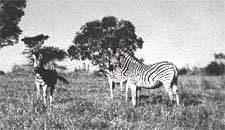BOTSWANA
 At a time when alarms have been sounded over the slaughter of elephants and rhinos by poachers and killing of male lions by hunters, the wildlife in Botswana is facing a serious threat. An expanding cattle industry and hundreds of miles of new veterinary cordon fences have led to massive decline in the numbers of free-roaming animals in southern Africa.
At a time when alarms have been sounded over the slaughter of elephants and rhinos by poachers and killing of male lions by hunters, the wildlife in Botswana is facing a serious threat. An expanding cattle industry and hundreds of miles of new veterinary cordon fences have led to massive decline in the numbers of free-roaming animals in southern Africa.
Though the country has dedicated nearly 40 per cent of its territory to national parks and lesser wildlife areas, the land is not sufficient to sustain animal populations. Animals move from one place to other seasonally in search of food. During this period, if cattle fences, farms and human settlement block their way, the results can be devastating. According to estimates, the wildebeest population in central and southern Botswana declined by 94 per cent between 1979 and 1994, whereas the number of hartebeest went down by 83 per cent due to human disruption.
The Kuke cordon fence that separates the central Kalahari game reserve from better-watered areas to the north, has been blamed for death of thousands of animals as the fence has cut wildlife off from water and scarce grazing during severe droughts.
In the past two years, Botswana has built new fences that may pose a serious threat to wildlife in northern part of the country. The step has been taken in the wake of a cattle lung disease that seems to have originated from Namibia and affected cattle in Botswana in 1995. The fences may affect movements of elephants, zebras, buffalos, giraffes and antelopes that migrate between the two countries.
Related Content
- Gender mainstreaming strategy and action plan for the disposal of polychlorinated biphenyls (PCB) in Southern Africa
- The path that ends AIDS: global AIDS update 2023
- National 1.5°C compatible emissions pathways and consistent power sector benchmarks in Africa
- Southern Africa economic outlook 2021
- Renewables readiness assessment: Botswana
- Free to Shine: Africa united against childhood HIV
